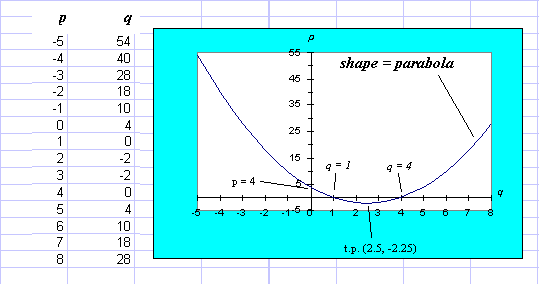
a) Use the Product Rule to differentiate the function:
p(q) = (q - 4)(q - 1)
b) Multiply out the brackets in p(q). Then show
that the differential of p(q) in this form is the
same as that obtained in part (a) above.
c) Determine the co-ordinates of the turning point of p(q),
and prove whether it is a maximum or a minimum.
d) Sketch the curve p(q).
e) What is the area beneath this curve between q = 0 and
q = 1 ?
1) Product Rule: dp/dq = u.(dv/dq) + v.(du/dq),
where u = (q - 4) and v = (q - 1).
So, du/dq = 1, and dv/dq = 1
Therefore the Product Rule gives:
dp/dq = (q - 1).1 + (q- 4).1
= 2q - 5
b) Multiplying out the brackets gives: p(q) = q2
- 5q +4
Differentiating this gives: 2q -5, as we found
before.
c) At the turning point, dp/dq = 0, so 2q - 5 =
0, so q = 2.5. Putting this value back into p(q),
we find that p = -2.25. So the turning point is at (2.5,
-2.25).
d2p/dq2 = +2, which
is positive. This means the turning point is a minimum.
Need to label every point where the curve cross an axis, plus the t.p, plus label the axes correctly.

e) Area is given by:  =
=  =
= 
Area = 1.833 sq. units (= sq.units)
sq.units)